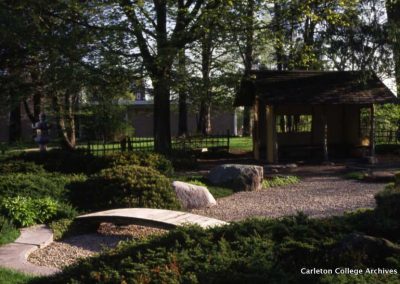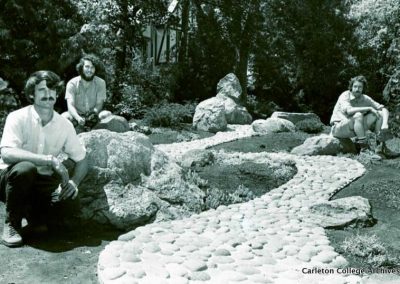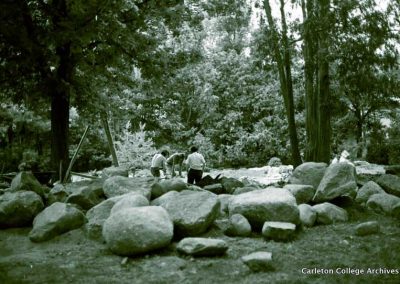The Japanese Garden
Clifford Clark
Carleton’s Japanese garden was named by The Journal of Japanese Gardening in 2000 as one of the ten best Japanese gardens outside Japan. Conceived by Bardwell Smith, Dean of the College and Nason Professor of Religion and Asian Studies, Emeritus, it was built from 1974 to 1976 by David Slawson.
The garden was designed to acknowledge the long history of Japanese students at Carleton as well as the college’s connection to the Kyoto program for American students that Smith helped start in 1970.
Sheltered by long-standing arborvitae, the garden is constructed out of ancient rocks from Minnesota. Lake Superior beach stones become a dry mountain stream that empties into a small lake of white gravel. The site has a serene and subtle beauty. Bordered by a tea house, it is designed as an oasis of serenity.
Mary Bigelow, a professional gardener who prunes the trees and bushes in the garden, said, “In Japanese culture, things that are aged and have survived in difficult times are respected.” She compared the Scotch pine in Carleton’s garden to those on Minnesota’s North Shore. “You see that one tree growing on the side of a cliff and you have no idea how it has managed. It’s stretching out, curling . . . and is sort of contorted looking. The fact that it is there alone is a miracle. You know it didn’t just happen yesterday. This tree has some stories to tell. It has survived how many winters and windstorms. It’s the same with [the Scotch pine in Carleton’s] Japanese garden.”
Smith said, “The garden seeks not to provide meaning but to animate inner reflection. We are not provided religious, philosophical, or any other interpretation . . . In this sense, the garden becomes an area of quiet listening, listening to one’s own inner spirit. Through experiencing such a garden’s quiet beauty and elegant simplicity one may be called into a more genuine awareness of our connections with the rest of existence.”





Recent Comments